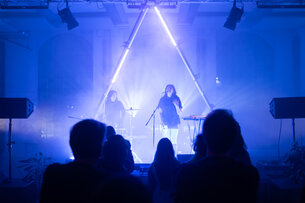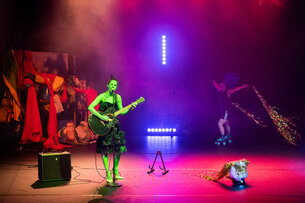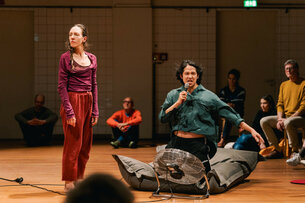Ends of Worlds
An interview with Michiel Vandevelde
by
Michiel Vandevelde & Esther Severi
Themes
On Stage
HOW CAN WE BELONG TOGETHER DESPITE OUR DIFFERENCES?
All copyrights belong to the Kaaitheatre, Brussels
Ends of Worlds is a science fiction dance production: how do you bring science fiction and dance together?
The combination was by no means self-evident. The 2017 solo production Andrade had a science fiction-like atmosphere, but it was more focused on the now. Science fiction implies a certain scientific character or pseudo-science. I wondered how one would combine this with something abstract like choreography. This presented a problem early on in the process: science fiction implies a narrative, while the dance that I love tends to be very abstract. In Ends of Worlds, I chose to create a science fiction story in a literal form around a set of dance materials.
You chose historical materials: you revisit the history of dance in the 20th and early 21st century and present capita selecta: references to German Expressionism and its influence on Butoh, Isadora Duncan, Kurt Jooss, Anna Halprin, Steve Paxton/contact improvisation, and even your own choreographic material. Is the narrative in part determined by this selection, or is it primarily the broader framework around the material that colours interpretations and readings of it?
As viewers, this production takes us forward into the future. We are hundreds of years ahead, and beyond a turning point at which the earth went from being a rich biotope to being a completely barren and desolate environment. A climate catastrophe has occurred. People can only survive thanks to extreme technological ‘enhancements’: bodies have literally become cyborgs. How did it come to this? The production assumes a double journey through time: the idea is that we as viewers find ourselves in the future and time travel back to the past from there. This journey to the past is shaped by (dance) materials – prompted by photos, film and text – that the future creatures found almost by accident.
All of the dance materials that we used specifically refer to the 20th century. That was a century that saw many great developments that many people still more or less remember. I am interested in the way in which recent dance history ran parallel with the dominant ideologies of the 20th century. Those ideologies are now re-emerging like ghosts from the past and are again starting to play a dangerous role in society. We see this in the rise of totalitarian regimes, of fascist tendencies in Europe, often combined with a form of neoliberalism – a scary cocktail that leads to something as yet unknown – but I fear that the future will not be very bright. The question is: how did we get here? I thought it would be interesting to distance myself from our present and to reflect on what is happening now from a future perspective. The American author Ursula K. Le Guin once said that science fiction is not about the future but is always about the present. J.G. Ballard talked about the ‘science fiction of the next five minutes’. Certain utopian or dystopian images are projected into the future but actually say much more about the present. They are magnified or minimized through the fiction of the future. And that is also what happens in this production. The dance material magnifies certain ideological tendencies.
How do you detect or name these ideologies in dance?
Art always reflects the zeitgeist. It often does so unconsciously, and it is interesting to analyse with hindsight how it is interpreted and how it operates exactly. How did artists react to their time and how can you read that in their work? The choreographies of Kurt Jooss, for example, are very dark and very figurative. Death was a prominent theme in much of his work. That is entirely due to the threat of fascism at the time. I interpret the work of artists like Anna Halprin as being at the forefront of an increasing individualization in which everything became possible in dance and in which dance incorporated actions that everybody can do, such as a sequence of dressing, undressing, dressing, undressing, etc. Starting in the 1960s-1970s, the prominent creed was: everyone is an artist!
Dance and the dancing body as a bearer of the zeitgeist is a theme that has played an important role since the beginning of your career. But you have always approached this from the perspective of the present, through popular music videos, modelling, etc. The new element is that you reflect on the past using historical material. How did you make that choice?
History and materials from the past have become more important in my recent work. That started with my last production, Paradise Now (2018), in which I worked with a group of young people to stage Paradise Now, a production first presented by The Living Theatre in 1968. And even more recently with my staging of the first book of Human Landscapes by the important 20th-century poet Nazim Hikmets. In Ends of Worlds, I continue this exploration of the 20th century, but focus more on the history of dance. How can we look at the past in order to say something about the present and the future? And how can we do so specifically through dance?
How do you deal with the interpretation and the activation of these historical materials?
Historically correct re-enactment has never been my primary purpose. I am much more interested in both the interpretation and misinterpretation of certain materials. That is why it helped to look back and reflect from the distant future. A material, for example a 70-year-old photograph, has a kind of graininess or a completely different quality than today’s photographs. Just like one of the photos that the Sonderkommando took in Auschwitz, and which we use as one of the backgrounds in the production. These photos have always been heavily debated because they were cropped a long time ago. This was done in order to make the central focus clearer. But as a result, the frame of the photo was erased (an open window or something like that), and as a viewer you can no longer see the horrendous conditions in which the photos were taken and the tremendous courage it took to take them. Interpretations change with time, and the ways in which things are transmitted can sometimes even lead to the opposite of the original objective. But certain interventions can also cause errors in today’s digital images and thus break them. The ageing of materials and the potential misinterpretations to which this can lead are speculative aspects that play a major role in the production. The old dance videos, often of bad quality, that we used as source materials, invite us to play a game with the mistakes, the glitches, and the black holes that are proper to this material. The entire process of the transmission of history always leads to new fictions. This has the potential to trigger our political imagination, both positively and negatively.
The surface of the material and the technological malfunctions that can occur also literally play a role in the production, and even infiltrate the dance itself. We see technology that fails: glitches, problems and various speeds alternate in the choreography. At the same time, the narrative refers to the extremely developed, technological enhancement of ‘bodies’ in the future. What do these contradictions seek to express?
Despite our great faith in technology, we are constantly surrounded by its failings. There is a prevalent view that digital technology is very good at conserving things. Seen from the perspective of the future, this is a somewhat naïve idea because so many things break over time.
But my aim here is not to critique digital technology as such, or at least less than in my previous productions like Antithesis, the future of the image (2015) or Andrade (2017). Rather, I use the digital and its ‘errors’ as a filter that has become so normal in our perception of reality both now, in the present, and in the future.
During the production, a voice tells us that by looking at dance from the 20th century, people in the future seek to discover how ‘organic’ people were capable of togetherness, of love, of community. Are these your fundamental questions for our current time?
Especially in Europe, we are no longer part of one interpretable world. Due to various developments and due to migration history, this continent is no longer as homogenous as it seemed to be not so very long ago. We no longer have one set of values, one ethical code or a universal declaration that structures our lives. At the same time, you sense everywhere that there is an enormous need for a sense of belonging, but at the moment that is expressed primarily in total polarization: on the one hand in racism and nationalism, and on the other in minority groups who retreat into themselves. My question is one that has been posed by various thinkers continuously over the past fifty years, and which remains unanswered: how can we belong together despite our differences? Or in other words, how can you create universality through difference – which is in itself a contradiction. You can resort to certain ideologies or you can become completely indifferent, but apathy gets us nowhere. We find ourselves in an impasse – how can we get out of it? We cannot return to a pillared society, to the very rigid structures of the past, but a more collective – I would even dare to say anarchic approach – likewise appears to be a tremendous challenge.
Parallel with this production, you are also working on a new production, Neuer Neuer Neuer Tanz, in cooperation with the Folkwang Tanzstudio (Essen, Germany). This dance company was founded in 1928 by Kurt Jooss, upon whose legacy you continue to build. Is this historical interest a trajectory that you will develop further in the future? What will the future bring?
Ends of Worlds is first and foremost about exploring political systems, but on a more personal level, it is about looking at dance and learning about dance throughout history. I went into dance very intuitively simply because I like to move, and probably also because my mother, who was a movement therapist, often took me to dance productions. My work has always been relatively theatrical, and theatricality also plays a central role in this production, but I am increasingly interested in exploring dance as such. In Essen, I am more focused on creating choreographies based on a history of dance that is linked to the centenary of the Folkwang Tanzstudio. I explore what we can do with dance today. A renewal is currently taking place in contemporary dance – the last major evolution was the conceptual wave of the 1990s. Where are we going now?
At the same time, the question of the human remains prominent in my work, which is expressed more explicitly in productions like Human Landscapes – Book 1 (2018) and the second book that is almost finished (September 2019), based on deeply human stories, which to me have a certain timelessness.
Generally speaking, various trajectories are developing in my work, which are related to different questions. I conceive of art as a place for reflection: about what it means to be human, to be together, to live together and to belong to an environment. And also: about how we can do that differently. But at the same time, I see art as a reflection in itself: Ends of Worlds and Neuer Neuer Neuer Tanz are about dance as such. I am also pursuing a more direct, political line in my work, which I call The Political Party. Next season, I am developing a science fiction parliament with children as a part of this project: again we find ourselves after a crash, surrounded by urban structures and city halls that stand empty and dilapidated, but in which children begin to develop new negotiation strategies.
I think of these different lines in my work as attempts to deal with the complexity of the present: learning to deal with multiplicity and to navigate within it, searching and trying different directions. To me, this search is absolutely vital at the moment.
Choreografie: Michiel Vandevelde Tanz: Jara Vlaeminckx, Abigail Aleksander, Jihee Kim, Robson Ledesma Kostüm: Lila John Bühnenbild: Ward Heirwegh, Michiel Vandevelde Dramaturgie: Esther Severi Licht: Tom Bruwier & Michiel Vandevelde Technik: Tom Bruwier Produktion: Disagree. vzw Ko-Produktion: PACT Zollverein, Kaaitheater, Buda, Pianofabriek Internationaler Vertrieb: Something great Finanzen: Klein Verzet vzw Residenzen: Stuk, Kaaitheater, PACT Zollverein, Buda, Pianofabriek Unterstützt von: De Vlaamse Overheidand de Vlaamse Gemeenschapscommissie













